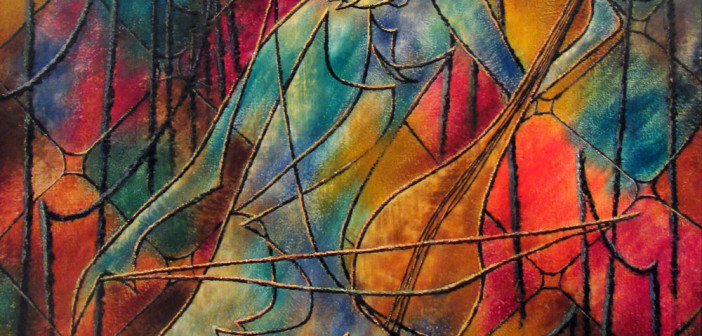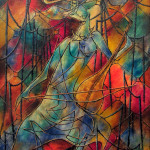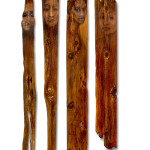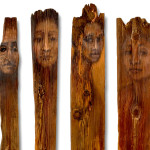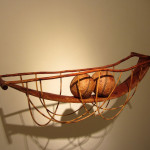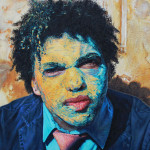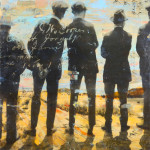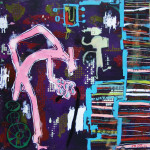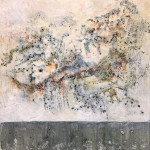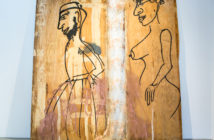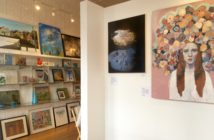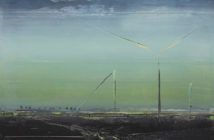On October 5 MassWax and International Encaustic Artists opened their juried exhibition The Future of the Past: Encaustic Art in the 21st Century at the Mills Gallery in Boston. Curated by Harriet Chenkin and Barb Cone, the show introduces viewers to the history of encaustic painting’s midcentury rebirth in the United States, and to the encaustic work of 32 North American artists. Given the recent surge in the medium’s popularity, this show, with short films and excellent written material, is as well timed as it is intellectually and visually satisfying.
As part of a small but engaging historical launch pad, The Future of the Past includes a wonderfully surreal painting by Karl Zerbe, a German Jew who emigrated to the US in 1934. Settling in Boston, he introduced encaustic painting to American students during his 18-year tenure at the School of the Museum of Fine Arts. Next to Zerbe’s work, the show features paintings by two of his early students, David Aronson and Esther Geller, who currently lives in Massachusetts. The Rebec Player, Geller’s work from 1949, is a luminously animated world of represented sound. In its color variations and layered construction, the work visually emulates the sharps, flats, flourishes and diminuendos of the rebec - an instrument in use since the days of Moorish Spain. Vaguely Cubist, Geller’s thick, black lines define her subject and drape it in the flags and stems of musical notation. One can nearly hear the paint.
Michal Sagar and Jacqueline Mallegni are just two of the contemporary artists in Future of the Past who incorporate organic materials into their work. Sagar’s installation Totems consists of four vertical oak planks, each bearing the image of a different woman painted in earth tones and adorned in gold and copper leaf that seems to have eroded with time. Peering over the gallery like silent witnesses, they instill calm similar to that of faded drawings or Greco-Roman funerary portraits — their encaustic predecessors. With this piece, Sagar opens a meditative space between the present and the unknown days of our origins. Equally compelling is Mallegni’s sculpture Earth Mother Daughter. Suspended from the gallery ceiling, this minimalist boat is constructed of tied wood switches that support a keel of encaustic-sealed linen. In its hold rest two spheres. Whether they are read as celestial bodies or, as the artist suggests, the female spirit, their apparent mass and the boat’s form create an atmosphere of sustained buoyancy and a concept of a journey without beginning or end.
In contrast to these installations are a large-scale portrait by Zane Turner, and an equally large painting by Marybeth Rothman. The subject of Turner’s work What do you mean it’s going to crumble is his twin brother who, in a moment of anger and bewilderment, looks out from beneath a lava-like mask and directly at the viewer. Paradoxically, the mask does not conceal the subject; instead it hints that there is a much deeper, intransient spirit within him. The work is initially aggressive, but the sensual encaustic strokes of its subject’s eyes and amazing lips slowly draws one in to ask, who is this man...?
Marybeth Rothman also incites curiosity with The Clarksburg Decision, a stylish combination of photography, collage and painting. About half life-size, it presents a gathering of five men dressed in Depression era suits. As one looks at them standing on a platform, they look out across an open field dotted by a distant marker or finish-line banner. Unconnected words float by. There are no other clues as to why the men are present, but they themselves are what hold the viewer’s interest. Even though their faces cannot be seen, one senses in the group shared deliberation and, through the simple gesture of two shoulders touching, community between the men. Rothman’s layers of tinted encaustic lend sumptuous color to the scene and a smooth, slightly hazy surface through which one is tempted to step to become the group’s sixth member at this oddly momentous occasion.
Across The Future of the Past strong works abound, each sustaining interest in its execution, inventiveness and subject matter. Of the smaller-sized paintings, the jocularity of Christopher Jagmin’s color-splashed Clonck and the tenderness of Karen Krieger‘s Zen-inspired Mountain Dragon represent a diversity of range visitors will find. One would be well advised to set aside a few hours to visit the Mills Gallery by December 2 to view the show’s short films, to learn more about the rebirth of encaustic as an art form, and to enjoy an extraordinarily well-curated selection of art from across North America. To learn more, visit the show’swebsite.
UPDATE:
The exhibition is composed of historical, invited and juried artists. We regret the omission of the jurors from this review. The majority of the work on view in The Future of the Past were selected by the following jurors:
Barbara O'Brien, Chief Curator and Director of Exhibitions and Collections, The Kemper Museum of Contemporary Art, Kansas City, MO and former Editor-in-Cheif, Art New England; Judith Tannenbaum, Richard Brown Baker Curator of Contemporary Art, Museum of Art, Rhode Island School of Design, Providence, RI; Craig Bloodgood, Contemporary Curator, The Art Complex Museum, Duxbury, MA.
For more details on this correction, please read Barbara O'Brien's comment below.
- Esther Geller The Rebec Player, 1948 Encaustic on pressed wood board, 50″x39
- Michal Sagar Totems, 2011 Carved found wood, encaustic, gold and copper leaf, 72″x48″
- Michal Sagar Totems, 2011 Carved found wood, encaustic, gold and copper leaf, 72″x48″
- Jacqueline Mallegni Earth Mother Daughter, 2011 Washi , rattan, willow, encaustic, hemp twine and waxed linen, 13″x36″x9″
- Zane Turner What do you mean it’s going to crumble, 2011 Encaustic on wood panel, 36″x48″
- Marybeth Rothman The Clarksburg Decision, 2011 Encaustic and mixed media, 40″x40″
- Christopher Jagmin clonck, 2011 Encaustic and oil on wood. 12″x12″, 40″x40″
- Karen Krieger Mountain Dragon, 2011 Encaustic with casein, graphite wash and pigments on birch panel. 20″x16″
"The Future of the Past: Encaustic Art in the 21st Century" is on view October 5 -- December 2, 2012 at The Mills Gallery.
All images are courtesy of the artist and the Mills Gallery.

